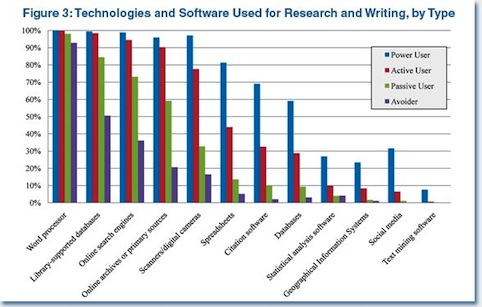Adoption Of New Media By Historians
Zotero’s Google word cloud— id: 279 title: ‘Adoption of “New” Media by Historians’ date: 2010-10-28T21:49:52-04:00 layout: post guid: http://quintessenceofham.org/?p=279 permalink: /2010/10/28/adoption-of-new-media-by-historians/ topsy_short_url:
- http://is.gd/goyRA dsq_thread_id:
- “6300066554” categories:
- nerd tags:
- profession
- research
- salume
- Stockholm Syndrome
-
technophobia
Rob Townsend recently published some fascinating analysis of historians’ usage of digital content and tools. I think the overall takeaway message has to be unequivocally grim: historians are not, by any stretch of the imagination, actively engaging with new materials and methods. Before I dig into the study, let me say that any criticism which emerges is in no way directed at Townsend, who teases out a remarkable amount of valuable data from a group that comes across as not only reluctant to adopt technology but often deeply suspicious of it.
Townsend’s analysis is divided into three key areas: user type, tool usage, and online publishing. I’m just going to look at tool usage here since those results intersect most closely with my own research interests. That said, I’m going to do away with the original analysis’s categorization according to user type, which when represented graphically tends to paint a rosier picture of technology usage than is in fact the case.

In the original chart, the tiny category of “power users” (less than 5% of the total survey) props up the chart bars all the way across the list. For example, their “social media” usage exceeds 30%. The effect is a chart that, while showing a decline in usage as technology becomes more sophisticated, obscures just how precipitous that decline actually is:

We see here that the actual overall usage of social media is just under 6%.1 With the revised chart, we also find that technology usage breaks into three distinct categories. The first group includes: word processor (99%); library-supported databases (94%); online search engines (88%); online archives or primary sources (81%); and scanners/digital cameras (65%).
All of these tools find rather high levels of usage across the board, but then again, I imagine that so would things like “telephone” and “automobile.” Indeed one would be hard pressed to find anyone in higher education (or indeed in the developed world) who does not make at least occasional use of a word processor, a search engine, and a digital camera. Library-supported databases and online sources have been growing dramatically in recent years, but to date these have largely served as substitutes for traditional media. In other words it’s not at all clear that these last two resources have yet had any more transformative effect on historical scholarship than, say, “photocopier.” I think that we can all agree that these are not specialized tools in any sense at all.
The next category follows a steep drop in usage. Here we find: spreadsheets (37%); citation software (27%); and databases (25%).
While we’re now beyond the everyday, nothing here is particularly “new” in this “new media.” We’re talking about tools that have been widely available for not just years but decades. Are three-quarters of all historians really not using a database to organize any aspect of their research? And what about this “citation software”? What historian doesn’t use citations? Just over a quarter of this study’s respondents acknowledged any use of citation software, which has been around in a variety of really solid and usable forms for over a decade (and is often purchased institutionally by universities and supported by their libraries). Do historians really savor a hand-crafted Chicago footnote like some morsel of artisanally-cured salume? Yes, yes they do.
This last lack of adoption is so bizarre as to boggle the mind. If our colleagues elsewhere in the university had any idea that we as a discipline write our own citations, they would rightly think us insane. Sure it’s not particularly difficult to draft your citations manually, but it’s also not especially hard to write your manuscript longhand or to take notes on 3×5 cards or to make your own soap or grow your own food or build a fire from twigs.2 But shouldn’t we be investing our time more profitably, say, in reading things or writing things that can’t be computer-generated in an instant?
Returning to the survey results, after another dramatic decline in usage, we find: statistical analysis software (9%); Geographical Information Systems (7%); social media (6%); and text-mining software (1%).
Now we’re in the zone of tools that are quite clearly barely used at all, but this is also finally the area that really seems to include newish things, excepting of course stats packages, which in a cool finding Townsend discovers older historians are more likely to use.3 Still, I have to wonder what 6% of historians are doing with social media in their research and writing. While it’s a little disturbing — though not particularly surprising — that the vast majority of historians remain resistant to new technology, I would be extremely interested in learning more about what this tiny minority is doing with these tools and what kind of scholarly value they’re deriving from them.
Leave a comment